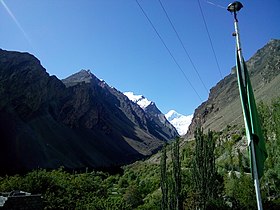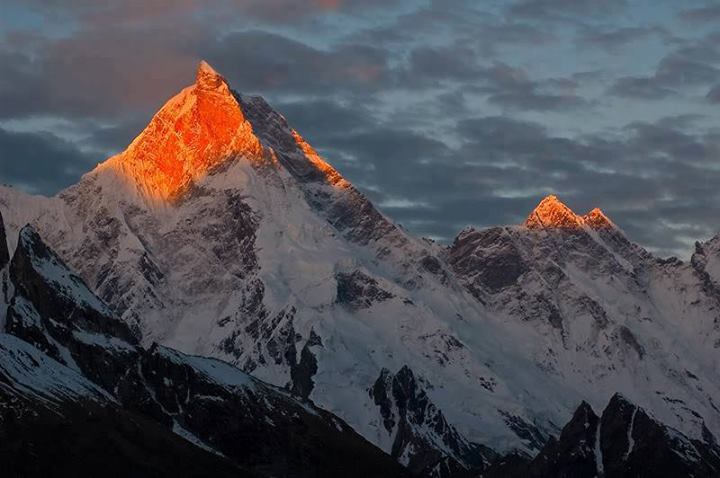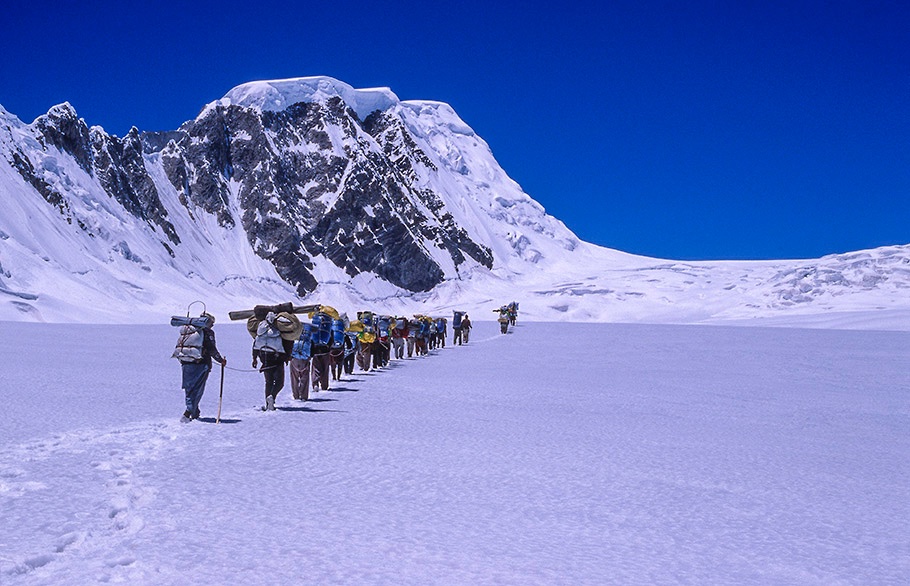| Revision as of 18:55, 22 July 2008 editSer Amantio di Nicolao (talk | contribs)Autopatrolled, Administrators6,319,341 editsm clean up and re-categorisation per CFD using AWB← Previous edit | Latest revision as of 02:13, 30 October 2024 edit undoPizzapenguins (talk | contribs)Extended confirmed users3,295 editsm →History | ||
| (190 intermediate revisions by more than 100 users not shown) | |||
| Line 1: | Line 1: | ||
| {{More citations needed|date=December 2008}} | |||
| ]]] | |||
| {{Use dmy dates|date=September 2020}} | |||
| '''Nagar''' (].نگر) is a town near to the ] and ] valleys in the ] of ]. The town is located in ] and was the capital of the former ]. | |||
| {{Infobox settlement | |||
| | name = Nagarkhas | |||
| | native_name = {{lang|ur|نگرخاص}} | |||
| | settlement_type = | |||
| | image_skyline = Nagar Proper, Gilgit Baltistan, Pakistan.jpg | |||
| | imagesize = 250px | |||
| | coordinates = {{coord|36.2764|N|74.72|E|display=inline,title}} | |||
| | image_alt = | |||
| | image_caption = Nagarkhas | |||
| | image_map = | |||
| | mapsize = 250 px | |||
| | map_alt = | |||
| | map_caption = | |||
| | pushpin_map = Gilgit Baltistan#Pakistan | |||
| | pushpin_label = Nagar | |||
| | pushpin_label_position = top <!-- left, right, top, bottom, none --> | |||
| | pushpin_map_alt = | |||
| | pushpin_mapsize = | |||
| | pushpin_map_caption = | |||
| | subdivision_type = Sovereign state | |||
| | subdivision_name = {{Pak}} | |||
| | subdivision_type1 = Dependent territory | |||
| | subdivision_name1 = ] | |||
| | subdivision_type2 = District | |||
| | subdivision_name2 = ] | |||
| | population_total = | |||
| | population_as_of = 1998 | |||
| | population_est = | |||
| | pop_est_as_of = | |||
| | population_footnotes = | |||
| | area_total_km2 = | |||
| | elevation_m = 2,688 | |||
| | elevation_m_min = | |||
| | elevation_m_max = | |||
| | population_density_km2 = | |||
| | leader_title = | |||
| | leader_name = | |||
| | leader_title1 = | |||
| | leader_name1 = | |||
| | area_code = | |||
| | website = | |||
| | footnotes = | |||
| | official_name = | |||
| | module = {{Infobox mapframe |wikidata=yes |zoom=16|coord={{WikidataCoord|display=i}}}} | |||
| }} | |||
| '''Nagarkhas''' ({{langx|ur|نگرخاص}}), also known as '''Oyum-Nagar,''' serves as the administrative center for the ] in ] region of Pakistan and is one of the main towns of the district. Located along the Nagar River, this town also held the distinction of being the capital of the erstwhile princely state of ]. | |||
| Today, the famous ] crosses Nagar, connecting ] to ] via the ]. The road follows the ] for some distance through Nagar and into the ] region. | |||
| ==Location== | |||
| ], with a shoe store ]]] | |||
| The Nagar valley is situated at an elevation of 2,438m (7,999 feet). Nagar Khas is the main town and the capital of the former ]. Ghulmet, Minapin, Chaprote and Hopper Valleys are popular tourist attractions in the Nagar region because of the spectacular scenery of the surrounding mountains such as ] at 7,788m (25,561 feet), and ], and ] peak (Golden peak.) | |||
| Today, the renowned ] traverses through Nagar, establishing a crucial connection between ] and ] via the ]. This roadway traces the course of the Hunza-Nagar River for a portion of its journey, passing through Nagar and extending into the Hunza District. | |||
| ==Early history== | |||
| Nagar and Hunza were originally one principality known as Buroshall, with the capital at Capal Dongs {{Fact|date=September 2007}}. After the reign of Miyor Khan, his sons divided Buroshall into Nagar and Hunza and declared the river as the border: Muglot became the king of Nagar and Kirkis became the king of Hunza. | |||
| ==Location== | |||
| ==Anglo-Brusho war== | |||
| ] | |||
| The British ] of 1889-1892 is known locally as the "Anglo-Brusho War". The British awarded three ] during this campaign. The British gained control of Nagar during a battle at ] (Jangir-e-Laye) in 1891. The Tham (Chief) of that time Azur Khan was sent in exile to ]. As a result Nagar had become a ] of the Kashmir Durbar, but was ruled by the same royal family. | |||
| ] | |||
| ] | |||
| Nagar is situated within the Nagar River valley, approximately five miles southeast of the junction where the Nagar River meets the Hunza River, and is positioned just below ].<ref name="Tilman2016">{{citation|last=Tilman|first=H.W.|title=Two Mountains and a River: I made a resolve not to begin climbing until assured by a plague of flies that summer had really come|url=https://books.google.com/books?id=_6M9DQAAQBAJ&pg=PT119|year=2016|publisher=Vertebrate Publishing|isbn=978-1-909461-31-4|pages=119–}}</ref> | |||
| The Nagar Valley, historically known as Broshal, is situated at an elevation of 2,688 meters (8,822 feet). Nagarkhas, the primary town, also served as the capital of the former ]. Within the Nagar District, the Ghulmet, Minapin, BAR, Chaprote, and Hopper Valleys are renowned tourist destinations due to their breathtaking landscapes. The district is home to some of the world's most imposing high mountain peaks, including Rakaposhi at 7,788 meters (25,561 feet), ], the ] (also referred to as the Golden Peak), and several others. | |||
| Nagar remained a principality until 1947. Although never ruled directly by neighbouring ] or the ], Nagar and Hunza were a vassal of Kashmir from the time of Maharaja Ranbir Singh of Jammu and Kashmir. The Mirs of both sent an annual tribute to the Kashmir Durbar until 1947, and the mir of Nagar, along with the ruler of Hunza, was considered to be among the most loyal vassals of the Maharaja of Kashmir. | |||
| ] | |||
| ==After independence== | |||
| In 1974, ] dissolved the Princely States of Nagar and Hunza and gave democratic representation to the Northern Areas Council, now known as the Northern Areas Legislative Council. | |||
| Rakaposhi Peak, Nagar (Gulmet) | |||
| Administratively there are two ]s in Nagar: Nagar-1 and Nagar-2 of ]. | |||
| ==Geography== | |||
| The state bordered the ] to the south West, the ] in the North-Eastern and to the north and ] to the northwest. The state capital was the town of Nagar Khas (also known as Uyum Nagar, means the Mighty Nagar Empire). The First valley of Nagar is Chalt Valley near Guroo, Janglote from ] and Last valley of Nagar is ], Biafo Range that links Baltistan in Eastern range | |||
| ==Population== | |||
| According to the 1998 census, the population of the Nagar Valley was 85,000. | |||
| ==Religion== | |||
| The population are almost entirely Shia Muslims of the ] sect. | |||
| ] | |||
| ==Famous Peaks and Valleys== | |||
| ] and ] Peaks are situated in Nagar-2, while ] (High altitude Wetland), ], Hopper Glacier, Hisper Glacier, Bowalter Glacier and Barpu white glaciers are in Nagar-1. | |||
| ==Climate== | |||
| The climate of Nagar remains pleasant from mid April to the end of September. The maximum temperature in summer during the day is 25°C. The weather becomes very cold during the winter, mainly from October to the end of March. The minimum temperature can be -8°C. | |||
| Hisper Biafo Glacier, Nagar (Hisper) | |||
| ==Rakaposhi Community Park== | |||
| The whole of Nagar has been declared a "community park" by the people of Nagar to preserve endangered species such as the marco polo sheep, brown bears, and snow leopards. | |||
| == |
==History== | ||
| {{Main|Nagar (princely state)}} | |||
| *Leitner, G. W. (1893): Dardistan in 1866, 1886 and 1893: Being An Account of the History, Religions, Customs, Legends, Fables and Songs of Gilgit, Chilas, Kandia (Gabrial) Yasin, Chitral, Hunza, Nagyr and other parts of the Hindukush, as also a supplement to the second edition of The Hunza and Nagyr Handbook. And An Epitome of Part III of the author’s “The Languages and Races of Dardistan.” First Reprint 1978. Manjusri Publishing House, New Delhi. | |||
| Following the ] of 1889–1892 (known locally as the Anglo-Burusho war) the area came under British control and then became a ] of the Kashmir durbar but continued to be ruled by the royal family of Nagar. In 1974, ] dissolved the princely states of Nagar and Hunza and gave them democratic representation in the Northern Areas Council, now known as the Gilgit-Baltistan Legislative Assembly. The British wanted to expand trade with Russia from both Nagar and Hunza, but the states would not permit them to do so.{{Citation needed|date=September 2023}} | |||
| *Where three Empires meet by E.F.Night. | |||
| *Buroshall Say Nagar Tak ka Safar by Mohammad Ismail Taseen. | |||
| Brushaal Ke Qabail by Syed Yahya Shah | |||
| ==See also== | |||
| *] | |||
| *] | |||
| *] | |||
| ==References== | ==References== | ||
| {{reflist}} | {{reflist}} | ||
| ==Bibliography== | |||
| ] | |||
| * {{citation |first=Peter |last=Nicolaus |chapter=The Taming of the Fairies |editor1=Uwe Bläsing |editor2=Victoria Arakelova |editor3=Matthias Weinreich |title=Studies on Iran and The Caucasus: In Honour of Garnik Asatrian |url=https://books.google.com/books?id=iLS9CwAAQBAJ&pg=PA225 |year=2015 |publisher=BRILL |isbn=978-90-04-30206-8 |pages=225–}} | |||
| ] | |||
| ==Further reading== | |||
| *Leitner, G. W. (1893): Dardistan in 1866, 1886 and 1893: Being An Account of the History, Religions, Customs, Legends, Fables and Songs of Gilgit, Chilas, Kandia (Gabrial) Yasin, Chitral, Hunza, Nagyr and other parts of the Hindukush, as also a supplement to the second edition of The Hunza and Nagyr Handbook. And An Epitome of Part III of the author's "The Languages and Races of Dardistan". First Reprint 1978. Manjusri Publishing House, New Delhi. | |||
| *Where three Empires meet by E.F.Night. | |||
| *Buroshall Say Nagar Tak ka Safar by Mohammad Ismail Tehseen. | |||
| *Brushaal Ke Qabail by Syed Yahya Shah | |||
| *Rakaposhi Nagar (راکاپوشی نگر) (Travelogue, 2015) by ] | |||
| {{Nagar District}} | |||
| ] | |||
Latest revision as of 02:13, 30 October 2024
| This article needs additional citations for verification. Please help improve this article by adding citations to reliable sources. Unsourced material may be challenged and removed. Find sources: "Nagarkhas" – news · newspapers · books · scholar · JSTOR (December 2008) (Learn how and when to remove this message) |
Place in Gilgit–Baltistan, Pakistan
| Nagarkhas نگرخاص | |
|---|---|
 Nagarkhas Nagarkhas | |
  | |
| Coordinates: 36°16′35″N 74°43′12″E / 36.2764°N 74.72°E / 36.2764; 74.72 | |
| Sovereign state | |
| Dependent territory | Gilgit–Baltistan |
| District | Nagar District |
| Elevation | 2,688 m (8,819 ft) |
Nagarkhas (Urdu: نگرخاص), also known as Oyum-Nagar, serves as the administrative center for the Nagar District in Gilgit–Baltistan region of Pakistan and is one of the main towns of the district. Located along the Nagar River, this town also held the distinction of being the capital of the erstwhile princely state of Nagar.
Today, the renowned Karakoram Highway traverses through Nagar, establishing a crucial connection between Pakistan and China via the Khunjerab Pass. This roadway traces the course of the Hunza-Nagar River for a portion of its journey, passing through Nagar and extending into the Hunza District.
Location



Nagar is situated within the Nagar River valley, approximately five miles southeast of the junction where the Nagar River meets the Hunza River, and is positioned just below Baltit.
The Nagar Valley, historically known as Broshal, is situated at an elevation of 2,688 meters (8,822 feet). Nagarkhas, the primary town, also served as the capital of the former princely state of Nagar. Within the Nagar District, the Ghulmet, Minapin, BAR, Chaprote, and Hopper Valleys are renowned tourist destinations due to their breathtaking landscapes. The district is home to some of the world's most imposing high mountain peaks, including Rakaposhi at 7,788 meters (25,561 feet), Diran, the Spantik (also referred to as the Golden Peak), and several others.
Rakaposhi Peak, Nagar (Gulmet)
Hisper Biafo Glacier, Nagar (Hisper)
History
Main article: Nagar (princely state)Following the Hunza-Nagar Campaign of 1889–1892 (known locally as the Anglo-Burusho war) the area came under British control and then became a vassal of the Kashmir durbar but continued to be ruled by the royal family of Nagar. In 1974, Zulfiqar Ali Bhutto dissolved the princely states of Nagar and Hunza and gave them democratic representation in the Northern Areas Council, now known as the Gilgit-Baltistan Legislative Assembly. The British wanted to expand trade with Russia from both Nagar and Hunza, but the states would not permit them to do so.
References
- Tilman, H.W. (2016), Two Mountains and a River: I made a resolve not to begin climbing until assured by a plague of flies that summer had really come, Vertebrate Publishing, pp. 119–, ISBN 978-1-909461-31-4
Bibliography
- Nicolaus, Peter (2015), "The Taming of the Fairies", in Uwe Bläsing; Victoria Arakelova; Matthias Weinreich (eds.), Studies on Iran and The Caucasus: In Honour of Garnik Asatrian, BRILL, pp. 225–, ISBN 978-90-04-30206-8
Further reading
- Leitner, G. W. (1893): Dardistan in 1866, 1886 and 1893: Being An Account of the History, Religions, Customs, Legends, Fables and Songs of Gilgit, Chilas, Kandia (Gabrial) Yasin, Chitral, Hunza, Nagyr and other parts of the Hindukush, as also a supplement to the second edition of The Hunza and Nagyr Handbook. And An Epitome of Part III of the author's "The Languages and Races of Dardistan". First Reprint 1978. Manjusri Publishing House, New Delhi.
- Where three Empires meet by E.F.Night.
- Buroshall Say Nagar Tak ka Safar by Mohammad Ismail Tehseen.
- Brushaal Ke Qabail by Syed Yahya Shah
- Rakaposhi Nagar (راکاپوشی نگر) (Travelogue, 2015) by Mustansar Hussain Tarar
| Nagar District | |
|---|---|
| Populated places |
|

